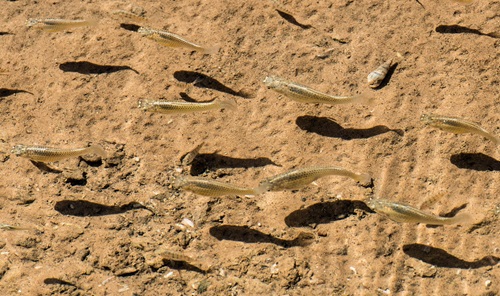Water Resource Management Strategies

Sailfin mollies and juvenile tilapia swim in a drainage ditch that flows into the Salton Sea in Imperial County, California. ©DWR/2017
The California Water Plan provides a broad set of resource management strategies (RMSes) that can help local agencies and governments manage their water and related resources. The RMSes can be a technique, program, or policy that can be used to meet water-related management needs of a region and the state as a whole. The 30-plus RMSes provide a comprehensive suite of tools that can be used to achieve a variety of intended outcomes by utilizing a diverse mix of strategies.
Resource Management Strategies
The RMSes can be considered as tools in a toolkit. Just as the mix of tools in any given kit depend on the job to be accomplished, the combination of strategies will vary from region to region, depending on climate, projected growth, existing water system, environmental and social conditions, and regional goals. At the local level, it's important the proposed strategies complement the operation of existing water systems. Some strategies may have little value in certain regions. Other strategies may have little value in particular conditions. For example, precipitation enhancement may not be effective during drought.
While most of the RMSes have multiple potential benefits, each area of California needs to select the right mix of strategies to achieve their intended outcomes. Actual RMS benefits depend on how the strategies are implemented. It's important to note that the water supply benefits of the RMSes are not additive. Although presented individually, the RMSes are alternatives that can complement each other or compete for limited system capacity, funding, water supplies, or other components necessary for implementation. Assumptions, methods, data, and local conditions vary per strategy. For this reason, the estimated benefits and costs should not be used to prioritize actions, policies, or proportion of State investment.
Update 2023 RMSes
 As part of the development of California Water Plan Update 2023 (Update 2023), 11 RMSes have been updated. The Update 2023 RMS updates reflect that climate change has driven water managers to develop and extend resource management for sustainability and resilience, and that social change has brought new focus to equity issues and community resilience. The new updates also illustrate how every strategy for managing water requires more consideration, skill, and sophistication to meet the demands of a decade of climate and social change. The RMS outline has also been revised to reflect Update 2023’s focus on three intersecting themes: addressing climate urgency, strengthening watershed resilience, and achieving equity in water management.
As part of the development of California Water Plan Update 2023 (Update 2023), 11 RMSes have been updated. The Update 2023 RMS updates reflect that climate change has driven water managers to develop and extend resource management for sustainability and resilience, and that social change has brought new focus to equity issues and community resilience. The new updates also illustrate how every strategy for managing water requires more consideration, skill, and sophistication to meet the demands of a decade of climate and social change. The RMS outline has also been revised to reflect Update 2023’s focus on three intersecting themes: addressing climate urgency, strengthening watershed resilience, and achieving equity in water management.
- Introduction
- Agricultural Water Use Efficiency
- Conjunctive Water Management
- Desalination
- Flood Management
- Municipal Recycled Water
- Precipitation Enhancement
- Recharge Area Identification, Utilization and Protection
- Reservoir Reoperation
- Urban Stormwater Runoff Capture and Management
- Urban Water Use Efficiency
- Watershed Management
If you have any questions, please contact us at cwpcom@water.ca.gov.
The California Water Plan Team will provide an overview of the updated RMSes on March 18, 2025, from 10 am - 12 pm via Zoom. Please register in advance. An agenda and Zoom link are available on DWR's event page.
Update 2013 Resource Management Strategies
Management Objectives
The RMSs are grouped into 8 different management objectives. For example, if you are looking for a way to improve water quality, look under the Improve Water Quality management objective.
RMS Archive
A record of information and drafts of updated RMSes are available.
Update 2023 - Public Review Draft
DWR has released a public review draft of the 11 RMSes on May 2024, for a 30-day comment period. Comments were reviewed and incorporated as appripiate.
The list below provides copies of the DRAFT public review draft versions of the RMSes.
- Introduction
- Agricultural Water Use Efficiency
- Conjunctive Water Management
- Desalination
- Flood Management
- Municipal Recycled Water
- Precipitation Enhancement
- Recharge Area Identification, Utilization and Protection
- Reservoir Reoperation
- Urban Stormwater Runoff Capture and Management
- Urban Water Use Efficiency
- Watershed Management
Contact Us
If you have any questions or want additional information of the resource management strategies, please email us .

